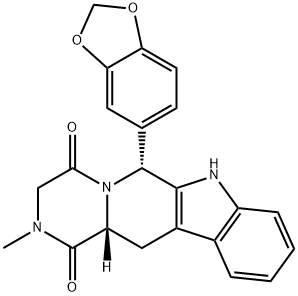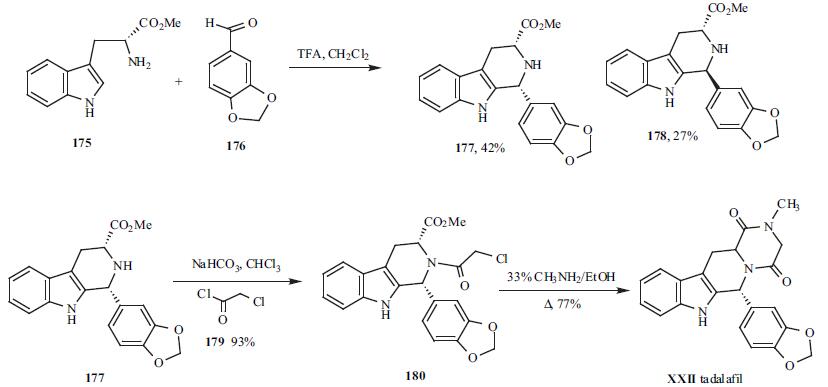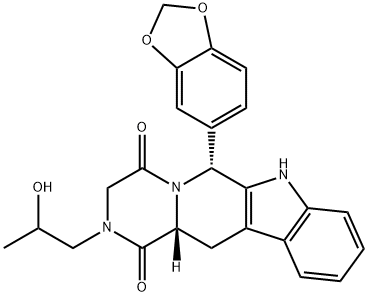Tadalafil
Synonym(s):(6R,12aR)-6-(1,3-Benzodioxol-5-yl)-2,3,6,7,12,12a-hexahydro-2-methylpyrazino[1′,2′:1,6]pyrido[3,4-b]indole-1,4-dione;ICI-351;Tadalafil
- CAS NO.:171596-29-5
- Empirical Formula: C22H19N3O4
- Molecular Weight: 389.4
- MDL number: MFCD07771966
- EINECS: 687-782-2
- SAFETY DATA SHEET (SDS)
- Update Date: 2025-12-23 13:58:55

What is Tadalafil?
Absorption
Tadalafil has a tmax of 0.5-6h with a median of 2h in healthy adults. The tmax in adults with PAH is reported as 2-8h with a median of 4h. There does not appear to be a significant effect on absorption when tadalafil is taken with food.
Toxicity
Symptoms of overdose are expected to be similar to typical adverse effects which may include headache, dyspepsia, back pain, myalgia, nasopharyngitis, and dizziness. Standard supportive care is recommended. Hemodialysis is not expected to contribute significantly to tadalafil clearance.
Description
Tadalafil (market name “Cialis” or “Adcirca”) is a kind of PDE5 inhibitor used for the treatment of erectile dysfunction, benign prostatic hypertrophy and pulmonary arterial hypertension. The effect of Tadalafil is relaxing the blood vessels muscles and increasing the blood flow into the corpus cavernosum. The mechanism of action of tadalafil is through inhibiting the activity of the cGMP specific phosphodiesterase type 5 (PDE5). PDE5 degrades cGMP in the corpus cavernosum located around the penis. Therefore, tadalafi leads to the increased concentration of cGMP which further causes the smooth muscle relaxation and increased blood flow into the corpus cavernosum. Some clinical studies also implied that tadalafil could improve endothelia function in men with increased cardiovascular risk and lower the urinary tract symptoms secondary to benign prostatic hyperplasia.
Chemical properties
White to Off-White Cyrstalline Solid
Originator
Lilly/ICOS (US)
The Uses of Tadalafil
analgesic, norepinephrine uptake blocker, mu-opiod receptor agonist.A phosphodiesterase 5 inhibitor.Tadalafil is used for the treatment of erectile dysfunction.
The Uses of Tadalafil
Tadalafil is used for the treatment of erectile dysfunction. A phosphodiesterase 5 inhibitor.
Indications
Tadalafil is indicated for the treatment of erectile dysfunction (ED) and either alone or in combination with finasteride for the treatment of benign prostatic hypertrophy (BPH). It is also indicated for the treatment of pulmonary arterial hypertension (PAH) both alone and in combination with macitentan or other endothelin-1 antagonists.
Background
Tadalafil is a selective phosphodiesterase-5 inhibitor that is used in the treatment of erectile dysfunction (ED), pulmonary arterial hypertension (PAH), and benign prostatic hypertrophy. It was first approved in 2003 by the FDA for use in ED and later in 2009 for PAH. In contrast to other PDE5 inhibitors like sildenafil, tadalafil has greater selectivity for PDE5 and a longer half-life which has made it a more suitable option for chronic once-daily dosing in the treatment of PAH.
What are the applications of Application
Tadalafil is a phosphodiesterase 5 inhibitor
Definition
ChEBI: Tadalafil is a pyrazinopyridoindole that is 2,3,6,7,12,12a-hexahydropyrazino[1',2':1,6]pyrido[3,4-b]indole-1,4-dione substituted at position 2 by a methyl group and at position 6 by a 1,3-benzodioxol-5-yl group (the 6R,12aR-diastereomer). A phosphodiesterase V inhibitor inhibitor, currently marketed in pill form for treating erectile dysfunction under the name Cialis; and under the name Adcirca for the treatment of pulmonary arterial hypertension. It has a role as an EC 3.1.4.35 (3',5'-cyclic-GMP phosphodiesterase) inhibitor and a vasodilator agent. It is a pyrazinopyridoindole and a member of benzodioxoles.
Preparation
Tadalafil is synthesized in three steps starting from D-tryptophan methyl ester, by first condensing with piperonal in a Pictet-Spengler cyclization reaction to form the tetrahydro-β-carboline derivative, which is followed by chloroacetylation of the piperidine ring nitrogen and cyclization with methylamine.
brand name
Cialis (Lilly).
General Description
Tadalafil, 171596-29-5, is a potent PDE5 inhibitor.It received FDA approval for the treatment of erectiledysfunction in December 2003. Because of its half-life of17.5 hours, it is marketed as a 36-hour treatment. Tadalafil ispredominantly metabolized by hepatic enzymes, includingCYP3A4. The concomitant use of CYP3A4 inhibitors suchas ritonavir, indinavir, ketoconazole, as well as moderateCYP3A inhibitors such as erythromycin have been shown toresult in significant increases in tadalafil plasma levels.Much like sildenafil, tadalafil is under clinical investigationfor managing PAH.
Mechanism of action
The mechanism of action of tadalafil is through inhibiting the activity of the cGMP specific phosphodiesterase type 5 (PDE5). PDE5 degrades cGMP in the corpus cavernosum located around the penis. Therefore, tadalafi leads to the increased concentration of cGMP which further causes the smooth muscle relaxation and increased blood flow into the corpus cavernosum. Some clinical studies also implied that tadalafil could improve endothelia function in men with increased cardiovascular risk and lower the urinary tract symptoms secondary to benign prostatic hyperplasia.
Pharmacokinetics
Tadalafil exerts a therapeutic effect in ED by increasing sexual stimulation-dependant smooth muscle relaxation in the penis, allowing the corpus cavernosum to fill with blood to produce an erection. Smooth muscle relaxation in the pulmonary vasculature helps to produce vasodilation in PAH which reduces blood pressure in the pulmonary arteries. In BPH, tadalafil may contribute to decreased smooth muscle cell proliferation which may reduce the size of the prostate and relieve the anatomical obstruction which produces urinary symptoms of BPH. The decreased affinity of tadalafil for PDE6 compared to other PDE5 inhibitors may explain the reduced incidence of visual side effects.
Pharmacokinetics
Tadalafil is different in structure from both sildenafil and vardenafil. It is rapidly absorbed and peaks in concentration (378 μg/L after a 20-mg dose) after 2 hours, displaying a long half-life of 17.5 hours. It also is metabolized by the liver (CYP3A4). Notably, its pharmacokinetics is not clinically influenced by alcohol or food intake or by factors such as diabetes or impaired hepatic or renal function.
Clinical Use
Tadalafil is one of the two new PDE5 inhibitors launched for the oral treatment of male erectile dysfunction. Tadalafil is a b-carboline derivative and it is structurally distinct from vardenafil (Levitraw) and sildenafil (Viagraw), both of which are PDE5 inhibitors based on a fused pyrimidine core structure.
Side Effects
The most common drug-related adverse events are headache, back pain, dyspepsia, and myalgia. At 10 and 20 mg doses, Tadalafil does not have a significant effect on blood pressure and heart rate and does not result in increased instances of myocardial infarction. Rare reports of prolonged erections greater than 4 h and priapism have been noted with the use of tadalafil. Priapism, if not treated properly, can result in irreversible damage to the erectile tissue. Patients who have an erection lasting greater than 4 h are advised to seek emergency medical attention.
Synthesis
D-(-)-Tryptophan methyl ester (175) and 1,3- benzodioxole-5-carboxaldehyde (176) were subjected to a modified Pictet-Spengler reaction to form cis- and transtetrahydro- |?-carboline tricyclic compounds. The ciscompound 177 was isolated as a white solid in 42% yield. The basic nitrogen in the piperidine ring of 177 was acylated with chloroacetyl chloride (179) to give compound 180 in 93% yield. Finally, the diketonepiperazine ring was formed by adding 180 to 33% methylamine in ethanol under refluxing conditions and yielded tadalafil (XXII) in 77% as a white solid.

Drug interactions
Potentially hazardous interactions with other drugs
Alpha-blockers: enhanced hypotensive effect - avoid
concomitant use.
Antibacterials: concentration possibly increased by
clarithromycin and erythromycin; concentration
reduced by rifampicin - avoid.
Antifungals: concentration increased by ketoconazole
- avoid; concentration possibly increased by
itraconazole.
Antivirals: concentration possibly increased by
fosamprenavir and indinavir; increased by ritonavir -
avoid; increased risk of ventricular arrhythmias with
saquinavir - avoid; avoid high doses of tadalafil with
telaprevir.
Cobicistat: concentration of tadalafil possibly
increased - reduce dose of tadalafil.
Nicorandil: possibly enhanced hypotensive effect -
avoid concomitant use.
Nitrates: enhanced hypotensive effect - avoid
concomitant use.
Riociguat: enhanced hypotensive effect - avoid
concomitant use.
Metabolism
Tadalafil undergoes hepatic metabolism via CYP3A4 to a catechol metabolite. This catechol metabolite undergoes subsequent methylation and glucuronidation with the methyl-glucuronide metabolite becoming the primary metabolite in circulation. None of the known metabolites are considered to be active.
Metabolism
Tadalafil(171596-29-5) is metabolised in the liver mainly by the cytochrome P450 isoenzyme CYP3A4. The major metabolite, the methylcatechol glucuronide, is inactive. Tadalafil is excreted, mainly as metabolites, in the faeces (61% of the dose), and to a lesser extent the urine (36% of the dose).
Interactions
Tadalafil can cause a serious drop in your blood pressure when used with nitrates, which can lead to dizziness, fainting, and rarely heart attack or stroke. Do not use any of the following with tadalafil or within 48 hours of your last dose of tadalafil: certain drugs used to treat chest pain/angina (nitrates such as nitroglycerin, isosorbide).
Side Effects
Common side effects of tadalafil happen in more than 1 in 100 people. For patients take it for erection problems, it is unlikely to get side effects as they only taking it for a short time. For patients take it for pulmonary hypertension, may get these side effects: Headaches, Feeling sick (nausea), Facial flushing and hot flushes, Indigestion, Stuffy nose, Muscle aches.
Storage
Store at -20°C
Clinical claims and research
In a study of 348 cases of mild to severe erectile dysfunction, patients were randomly given 20mg of Cialis or a placebo. Results showed that in comparison to the placebo group, patients who took Cialis experienced improved intercourse success in the 24-36 hours following medication, with many patients achieving successful sexual intercourse twice in 36 hours. Side effect rate and severity were also no different from those of the placebo group. Over 5% of patients in the Cialis group experienced headaches and indigestion.
Precautions
Patients currently taking nitrates, experiencing angina pectoris, suffering from heart disease, patients who have unregulated hypertension or hypotension, or patients who have had a stroke in the past 6 months should not take Cialis.
References
https://www.drugs.com/tadalafil.html
https://www.drugbank.ca/drugs/DB00820
Roehrborn, C. G., et al. "Tadalafil administered once daily for lower urinary tract symptoms secondary to benign prostatic hyperplasia: a dose finding study." Journal of Urology 180.4(2008):1228.
Rosano, Giuseppe M. C., et al. "Chronic Treatment with Tadalafil Improves Endothelial Function in Men with Increased Cardiovascular Risk." European Urology 47.2(2005):214-222.
Properties of Tadalafil
| Melting point: | 298-300°C |
| alpha | D20 +71.0° |
| Boiling point: | 679.1±55.0 °C(Predicted) |
| Density | 1.51±0.1 g/cm3(Predicted) |
| Flash point: | 2℃ |
| storage temp. | Sealed in dry,2-8°C |
| solubility | DMSO: soluble20mg/mL, clear |
| pka | 16.68±0.40(Predicted) |
| form | powder |
| color | white to beige |
| optical activity | [α]/D +68 to +78°, c = 1 in chloroform-d |
| Stability: | Unstable in Methanol |
| InChI | InChI=1S/C22H19N3O4/c1-24-10-19(26)25-16(22(24)27)9-14-13-4-2-3-5-15(13)23-20(14)21(25)12-6-7-17-18(8-12)29-11-28-17/h2-8,16,21,23H,9-11H2,1H3/t16-,21-/m1/s1 |
| CAS DataBase Reference | 171596-29-5(CAS DataBase Reference) |
Safety information for Tadalafil
| Signal word | Warning |
| Pictogram(s) |
 Exclamation Mark Irritant GHS07 |
| GHS Hazard Statements |
H315:Skin corrosion/irritation H319:Serious eye damage/eye irritation H335:Specific target organ toxicity, single exposure;Respiratory tract irritation |
| Precautionary Statement Codes |
P302+P352:IF ON SKIN: wash with plenty of soap and water. P305+P351+P338:IF IN EYES: Rinse cautiously with water for several minutes. Remove contact lenses, if present and easy to do. Continuerinsing. |
Computed Descriptors for Tadalafil
| InChIKey | WOXKDUGGOYFFRN-IIBYNOLFSA-N |
| SMILES | N1C2=C(C=CC=C2)C2C[C@]3([H])C(=O)N(C)CC(=O)N3[C@H](C3=CC=C4OCOC4=C3)C1=2 |
Tadalafil manufacturer
SRINI PHARMACEUTICALS PVT LTD
New Products
4,4-Difluoropiperidine hydrochloride tert-butyl 9-methoxy-3-azaspiro[5.5]undecane-3-carboxylate Indole Methyl Resin N-Isopropylurea N,N-Dicyclohexylcarbodiimide(DCC) MELDRUMS ACID 5-METHYLISOXAZOLE-4-CARBOXYLIC ACID Magnessium Bis glycinate Zinc ascorbate 1-bromo-2-butyne 2-acetamidophenol 9(10H)-anthracenone Erythrosin B, 4-Piperidinopiperidine 2-((4-morpholinophenylamino) (methylthio) methylene) malononitrile 2,4-dihydroxybenzaldehyde 3-(4-morpholinophenylamino)-5-amino-1H-pyrazole-4-carbonitrile Methyl 2-methylquinoline-6-carboxylate 2,6-dichloro-4-nitropyridine 4-Bromo-2-chlorobenzonitrile 2-(benzylamino)acetic acid hydrochloride 4-(tert-Butoxycarbonylamino)but- 2-ynoic acid 3,4-dihydro-2H-benzo[b][1,4]dioxepine 1-Phenyl-1-cycloprppanecarboxylicacidRelated products of tetrahydrofuran
![(1S,3S)-1-(1,3-Benzodioxol-5-yl)-2-(2-chloroacetyl)-2,3,4,9-tetrahydro-1H-pyrido[3,4-b]indole-3-carboxylic Acid Methyl Ester](https://img.chemicalbook.in/CAS/GIF/629652-42-2.gif)



![(1S,3R)-1-Benzo[1,3]dioxol-5-yl-2-(2-chloro-acetyl)-2,3,4,9-tetrahydro-1H-b-carboline-3-carboxylic Acid Methyl Ester](https://img.chemicalbook.in/CAS/GIF/629652-40-0.gif)

![(1R,3R)-2-acetyl-1-(benzo[d][1,3]dioxol-5-yl)-2,3,4,9-tetrahydro-
1H-pyrido[3,4-b]indole-3-carboxylate](https://img.chemicalbook.in/CAS/20180629/GIF/1598416-05-7.gif)
![(1R,3S)-1-(1,3-Benzodioxol-5-yl)-2-(2-chloroacetyl)-2,3,4,9-tetrahydro-1H-pyrido[3,4-b]indole-3-carboxylic Acid Methyl Ester](https://img.chemicalbook.in/CAS/GIF/629652-44-4.gif)
You may like
-
 Tadalafil 99%View Details
Tadalafil 99%View Details -
 Tadalafil 99%View Details
Tadalafil 99%View Details -
 Tadalafil 99%View Details
Tadalafil 99%View Details -
 Tadalafil 98%View Details
Tadalafil 98%View Details -
 Tadalafil 98%View Details
Tadalafil 98%View Details -
 Tadalafil 98%View Details
Tadalafil 98%View Details -
 Tadalafil 98%View Details
Tadalafil 98%View Details -
 Tadalafil Api PowderView Details
Tadalafil Api PowderView Details
171596-29-5
